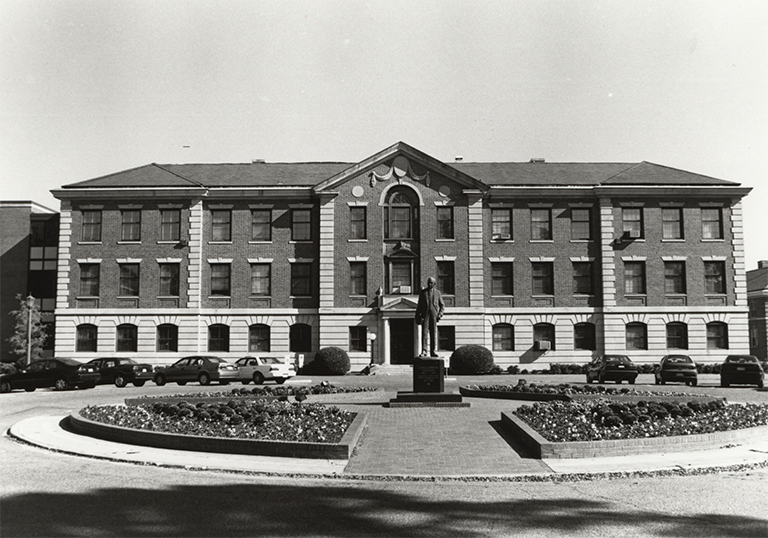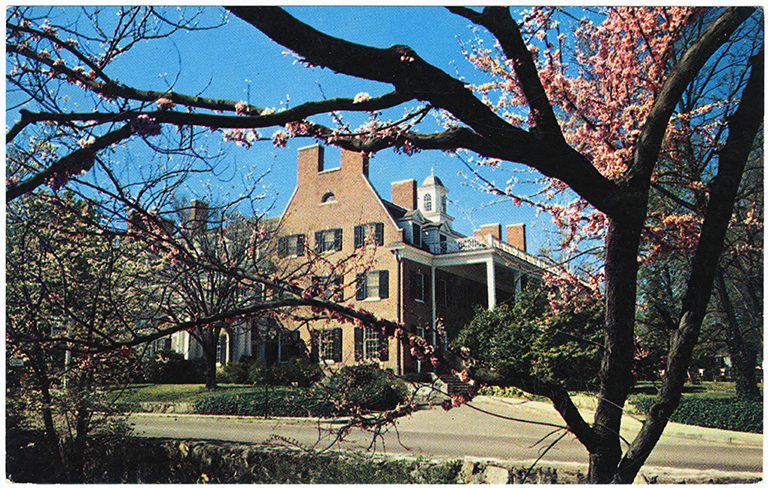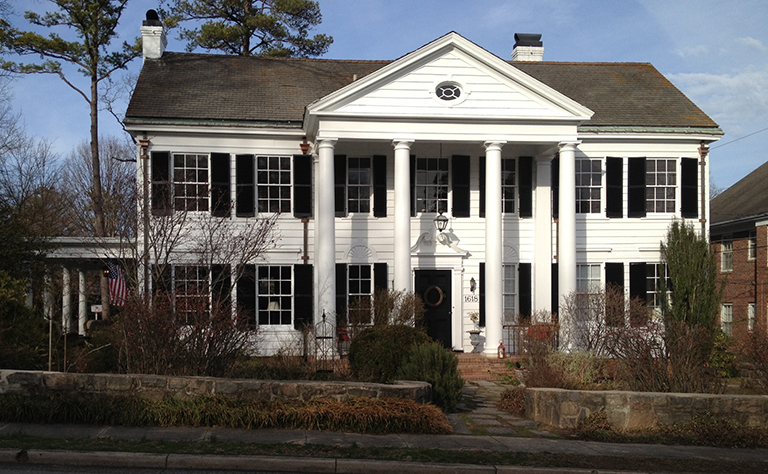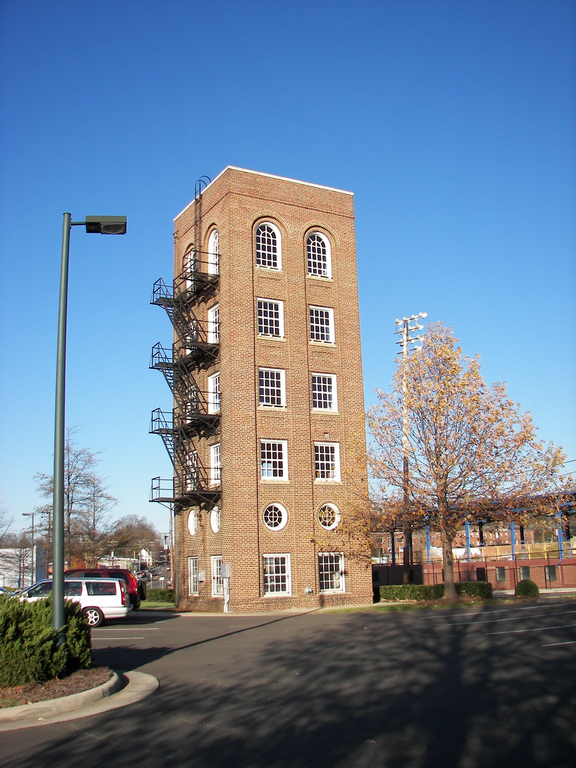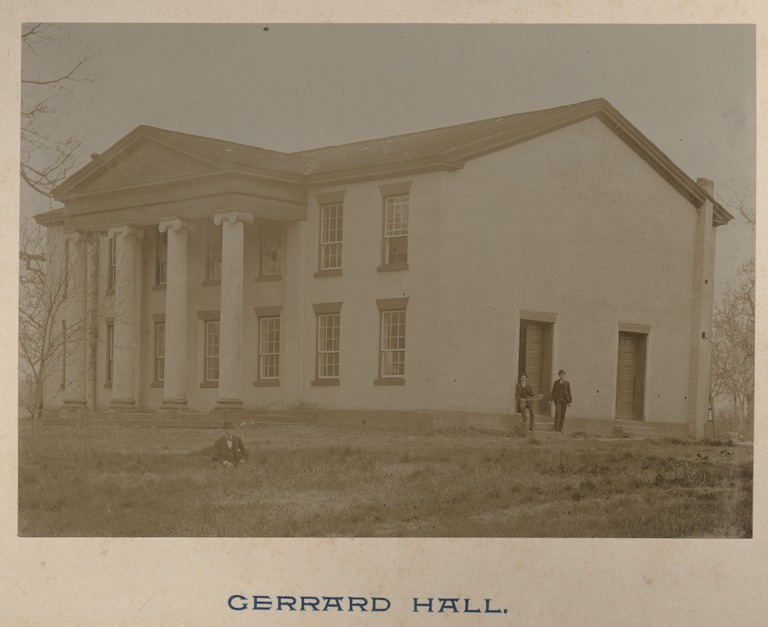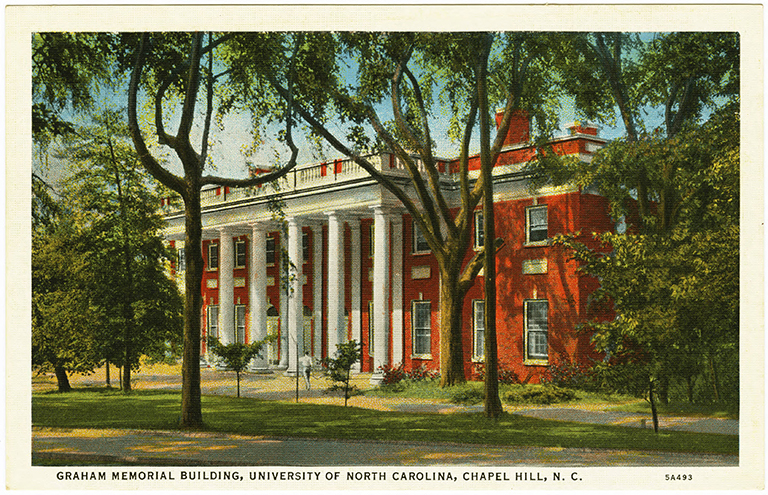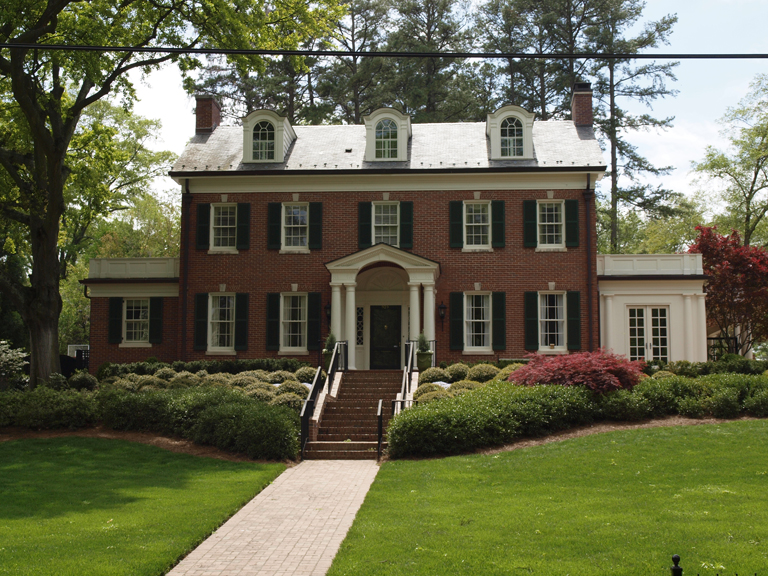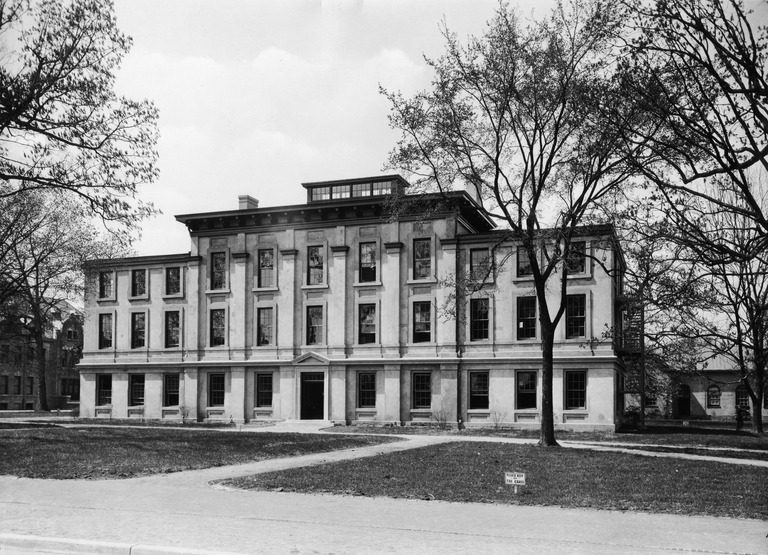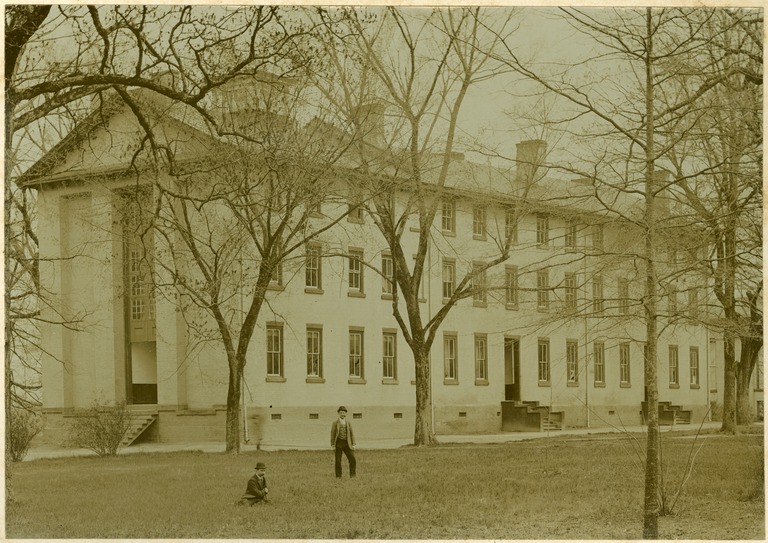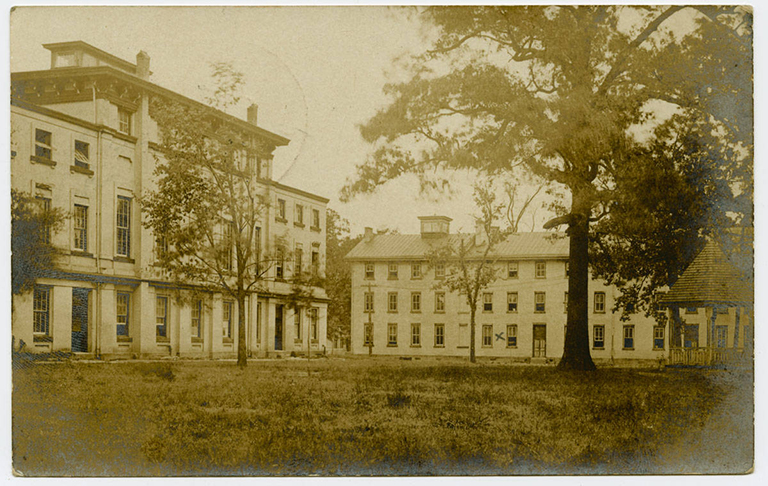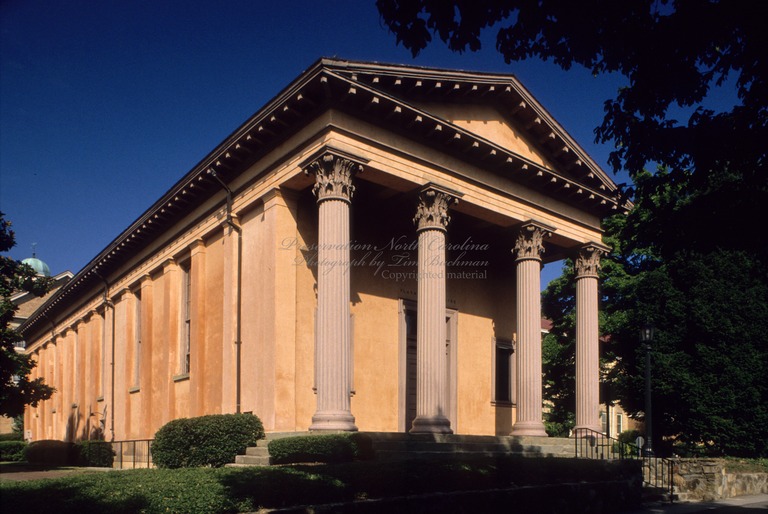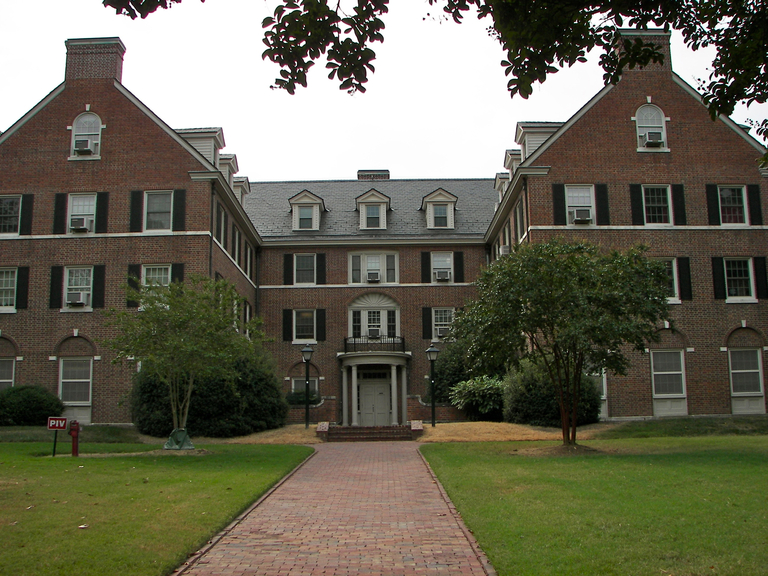Atwood and Nash
Variant Name(s):
Arthur C. Nash; Thomas C. Atwood
Founded:
North Carolina, USA
Residences:
- Asheville, North Carolina
- Chapel Hill, North Carolina
Trades:
- Architect
Building Types:
Styles & Forms:
Beaux-Arts; Colonial Revival; Georgian Revival; Mission; Spanish Colonial Revival
Atwood and Nash was a prolific engineering and architectural firm established in 1923 by engineer Thomas C. Atwood and architect Arthur C. Nash. Most of the firm’s work was in Chapel Hill, Durham, and Raleigh, but the partners also planned buildings in Wilmington, Asheville, and elsewhere. With differing backgrounds—Atwood in engineering and management, Nash as a Beaux-Arts trained architect—the two brought complementary skills to the partnership. Blueprints for their Alexander Sprunt House in Wilmington carry the official name of the firm in the corner, and T. C. Atwood also signed his name on a line for “engineer” and A. C. Nash signed his on a line for “architect.” More information about both men and their work appears in their individual biographical entries.
Atwood and Nash became associated in 1922, when Atwood was already the engineer in charge of the expansion of the University of North Carolina at Chapel Hill, heading up the T. C. Atwood Organization, and Nash arrived in the spring to replace H. P. Alan Montgomery as the lead architect in the organization.
At first Nash was simply identified as architect in the Atwood organization. Not long after Nash’s arrival in Chapel Hill, the Charlotte Observer of June 20, 1922 reported, the T. C. Atwood Organization was the architectural firm for the Carolina Inn, a hotel and club adjoining the campus in a private project led by John Sprunt Hill, the influential university leader. The Observer explained that a “tentative design” for the “Colonial structure” had been prepared by Arthur C. Nash, “the architect in the T. C. Atwood Organization, with the goal of having a building “distinctively Southern, impressive yet simple and friendly.”
According to university historian Louis Round Wilson, the partnership was formed in April 1922, but thus far no newspaper references to the partnership have been found from before 1923. The partnership was certainly in place by autumn of 1923. The Daily Tar Heel of March 27, 1923, identified the “architects of the T. C. Atwood Organization” as designers of the inn, and did so again on October 6, 1923. But the latter issue of the newspaper also cited Atwood and Nash, Inc., as architects for a facility for the university medical school, and the Daily Tar Heel of November 16, 1923 cited “the firm of Atwood and Nash” as “the University architects.” Thereafter, references to Atwood and Nash were frequent.
This firm also took on private and public projects beyond the university as well. These included several impressive Georgian Revival residences in Raleigh, Wilmington, and elsewhere. In addition, Atwood and Nash employed their familiar Georgian Revival vocabulary in red brick for new buildings for North Carolina Central University in Durham and for Peace College in Raleigh. The firm employed a dignified neoclassical treatment in stone for the Revenue Building in Raleigh to harmonize with the State Capitol across the street. A different spirit informed their State Fair Exhibition Buildings in Raleigh, an expansive, stuccoed structure with cheery Spanish character.
In 1929, Atwood and Nash decided to open an office in the booming mountain city of Asheville, where they had previously designed the Tudor Revival style John Sprunt Hill House in Biltmore Forest for Hill, a Durham resident and University of North Carolina leader with whom they had worked closely on university projects and the Carolina Inn. On October 22, 1929—just days before the stock market crashed and burst Asheville’s development bubble—the Asheville Citizen reported, “Atwood and Nash, Inc., architects, whose home offices are located in Chapel Hill, yesterday opened a branch office in Asheville, with Lindsey M. Gudger as local manager. The Asheville office is located in The Citizen Building, at 25 Haywood Street.” The Citizen noted that “T. C. Atwood, engineering member of the firm, was supervising engineer for the construction of the famous Yale Bowl. A. C. Nash, architectural member of the firm, is a graduate of the Beaux Arts, Paris, and has been identified with the modern architectural movement in various parts of the United States for a number of years. Since the present firm was organized six years ago, it has designed building projects whose value totals $30,000, 000.” The newspaper listed among the firm’s “major structures” the library, dormitories, and Kenan Stadium at the University of North Carolina; the Revenue Building and buildings at Peace College in Raleigh; the Masonic Orphanage in Oxford; the Goldsboro State Hospital; and university stadiums in Georgia and Alabama.
Gudger was identified as a native of Asheville educated in local schools, the University of North Carolina, and the Georgia Institute of Technology (Georgia Tech). “He has the distinction of being the only architect now practicing in Asheville who is a native of the city, and with the exception of Douglas D. Ellington is the only local architect who is a native of the State of North Carolina.” Although the Asheville branch office of Atwood and Nash was short-lived, Gudger went on to become a notable Asheville architect.
Atwood and Nash’s partnership continued until Nash’s retirement in 1930. Thereafter, Atwood formed a partnership with H. Raymond Weeks as Atwood and Weeks, with Nash serving in a consulting capacity.
- Asheville Citizen, Oct. 22, 1929.
- Archibald Henderson, The Campus of the First State University (1949).
- Louis Round Wilson, The University of North Carolina 1900-1930 (1957).
Alexander Dunn Hall
Contributors:Dates:1930
Location:Durham, Durham CountyStreet Address:North Carolina Central University Campus, Lawson St., Durham, NC
Status:Standing
Type:Educational
Images Published In:Claudia P. Roberts (Brown) and Diane E. Lea, The Durham Architectural and Historic Inventory (1982).
Alexander Sprunt House
Contributors:Dates:1929-1930
Location:Wilmington, New Hanover CountyStreet Address:1615 Chestnut St., Wilmington, NC
Status:Standing
Type:Residential
Note:Blueprints and specifications for the Sprunt house, by Atwood and Nash and signed by both men, survive in private hands and depict the evolution of the design of the large Colonial Revival residence.
Annie Day Shepard Hall
Contributors:Dates:1930
Location:Durham, Durham CountyStreet Address:North Carolina Central University Campus, Lawson St., Durham, NC
Status:Standing
Type:Educational
Images Published In:Claudia P. Roberts (Brown) and Diane E. Lea, The Durham Architectural and Historic Inventory (1982).
Note:The building was named for the wife of college president James Shepard; she was the granddaughter of the noted Caswell County cabinetmaker Thomas Day.
Baldwin's Department Store
Contributors:Dates:1927
Location:Durham, Durham CountyStreet Address:107 W. Main St., Durham, NC
Status:Standing
Type:Commercial
Images Published In:Claudia P. Roberts (Brown) and Diane E. Lea, The Durham Architectural and Historic Inventory (1982).
Carolina Inn
Contributors:Dates:1923-1924
Location:Chapel Hill, Orange CountyStreet Address:Corner of Cameron St. and Columbia St., Chapel Hill, NC
Status:Altered
Type:Commercial
Images Published In:M. Ruth Little, The Town and Gown Architecture of Chapel Hill, North Carolina, 1795-1975 (2006).
William S. Powell, The First State University: A Pictorial History of the University of North Carolina (1992).
Cheshire House
Contributors:Atwood and Nash, architects (ca. 1924); Thomas C. Atwood, engineer (ca. 1924); Arthur C. Nash, architect (ca. 1924); Howard E. Satterfield, builder (late 1910s)Variant Name(s):Bishop Joseph B. Cheshire House
Dates:late 1910s; ca. 1924
Location:Raleigh, Wake CountyStreet Address:1618 Ambleside Dr., Raleigh, NC
Status:Standing
Type:Residential
Note:Attorney Joseph B. Cheshire, Jr., son of the Episcopal bishop of the same name, appeared in the city directory of 1917 as residing on Hawthorne Road, and from 1918 onward had the address of 1618 Ambleside. (The property is located at the corner of the two streets.) It is believed that Satterfield built a moderate sized house for Cheshire at first, and then expanded or rebuilt it about 1924 as the present columned residence from designs by Atwood and Nash. Satterfield’s building list includes a job for Joe Cheshire.
Clyde R. Hoey Administration Building
Contributors:Dates:1929
Location:Durham, Durham CountyStreet Address:North Carolina Central University Campus, Lawson St., Durham, NC
Status:Standing
Type:Educational
Images Published In:Claudia P. Roberts (Brown) and Diane E. Lea, The Durham Architectural and Historic Inventory (1982).
Durham Fire Training Tower
Contributors:Dates:1928
Location:Durham, Durham CountyStreet Address:Washington St., Durham, NC
Status:Standing
Type:Public
Frederick Koch House
Contributors:Dates:1924
Location:Chapel Hill, Orange CountyStreet Address:Tenney Circle, Chapel Hill, NC
Status:Unknown
Type:Residential
Note:The Daily Tar Heel of October 18, 1924, reported that Atwood and Nash had designed a residence for Professor Koch.
George E. Kidder House
Contributors:Dates:1931
Location:Wilmington, New Hanover CountyStreet Address:2607 Hydrangea Dr., Wilmington, NC
Status:Standing
Type:Residential
Note:Atwood and Nash’s plans for the Georgian Revival residence survive in private hands.
Gerrard Hall
Contributors:Atwood and Nash, architects and engineers (1938); Thomas C. Atwood, engineer (1938); Arthur C. Nash, consulting architect (1938); William Nichols, architect (1822-1837); Thomas A. Waitt, builder (1837); H. Raymond Weeks, architect (1938)Variant Name(s):New Chapel
Dates:1822-1837; 1858 [improvements]; 1938 [internally reconstructed]
Location:Chapel Hill, Orange CountyStreet Address:University of North Carolina, Chapel Hill, NC
Status:Standing
Type:Educational
Images Published In:John V. Allcott, The Campus at Chapel Hill: Two Hundred Years of Architecture (1986).
M. Ruth Little, The Town and Gown Architecture of Chapel Hill, North Carolina, 1795-1975 (2006).
C. Ford Peatross, William Nichols, Architect (1979).
William S. Powell, The First State University: A Pictorial History of the University of North Carolina (1992).Note:As built from Nichols’s design, Gerrard Hall included an imposing Ionic portico on one side; the portico was removed ca. 1900, and recreated in 2007-2008. The hall was rebuilt internally in the 1930s.
Graham Memorial
Contributors:Atwood and Nash, architects; Thomas C. Atwood, engineer; William M. Kendall, architect; McKim, Mead and White, consulting architects; Arthur C. Nash, architect; T. C. Thompson, contractorDates:1929-1931
Location:Chapel Hill, Orange CountyStreet Address:University of North Carolina Campus, Chapel Hill, NC
Status:Standing
Type:Educational
Images Published In:M. Ruth Little, The Town and Gown Architecture of Chapel Hill, North Carolina, 1795-1975 (2006).
William S. Powell, The First State University: A Pictorial History of the University of North Carolina (1992).Note:The Daily Tar Heel of April 11, 1922 reported that Thomas C. Atwood and William Kendall (of McKim, Mead and White) had conferred with the Graham Memorial Building Committee concerning the best location for a campus edifice to honor the late university president, Edward Kidder Graham, an idea conceived as early as 1920. Other architects had been considered: Hobart B. Upjohn, R. B. McGoodwin, and Charles C. Hook. On May 12, the Daily Tar Heel reported that the T. C. Atwood Organization was busy working on plans; in the interim, architect Arthur C. Nash had come to Chapel Hill to serve as chief architect for the Atwood organization. The building was constructed in stages and remained unfinished for several years because donations sufficient for completion were slow in coming, but a large gift finally enabled it to be completed in 1931 and dedicated in January, 1932. Based on Archibald Henderson’s list of buildings, this was the last of the campus buildings for which the contractors were T. C. Thompson and Brothers; thereafter a variety of contractors constructed the university buildings. It was also the last for which the firm of McKim, Mead and White was listed as consulting architects to Arthur C. Nash.
Hill Hall
Contributors:Atwood and Nash, architects and engineers (1930); Thomas C. Atwood, engineer (1930); J. A. Jones, contractor (1907); Frank Pierce Milburn, architect (1907); Arthur C. Nash, architect (1930); Michael Heister, architectVariant Name(s):Carnegie Library
Dates:1907; 1930 [remodeled]
Location:Chapel Hill, Orange CountyStreet Address:University of North Carolina, Chapel Hill, NC
Status:Standing
Type:Educational
Images Published In:M. Ruth Little, The Town and Gown Architecture of Chapel Hill, North Carolina, 1795-1975 (2006).
Daniel J. Vivian, “‘A Practical Architect’: Frank P. Milburn and the Transformation of Architectural Practice in the New South, 1890-1925,” Winterthur Portfolio (Spring 2005).Note:The building was erected in 1907 as a library and was later expanded and updated as a music building; it has since been renovated again.
John Sprunt Hill House
Contributors:Dates:Ca. 1927
Location:Biltmore Forest, Buncombe CountyStreet Address:41-43 Hilltop Rd., Biltmore Forest, NC
Status:Standing
Type:Residential
Note:The large Tudor Revival house was designed by the firm of Atwood and Nash for business and university leader John Sprunt Hill. Biltmore Forest was a separate community, laid out with a golf course and other amenities, on a portion of the Biltmore Estate.
Jolly-Broughton House
Contributors:Atwood and Nash, architects; Thomas C. Atwood, engineer; Arthur C. Nash, architect; Howard E. Satterfield, builderVariant Name(s):Gov. J. Melville Broughton House
Dates:1928
Location:Raleigh, Wake CountyStreet Address:929 Holt Dr., Raleigh, NC
Status:Standing
Type:Residential
Note:The classic Georgian Revival house was built for Janie Jolly, the widow of Frank Jolly and was later purchased by Gov. Broughton. Satterfield’s building list includes a project for Mrs. Frank Jolly, and he is noted as the builder in the Hayes Barton National Register of Historic Places nomination. Blueprints for the house by Atwood and Nash (held by Special Collections Research Center, NCSU Libraries), show two phases of the design, the first in 1928 and a slightly simplified version in 1929. A recent renovation carried out some of the features that were originally omitted including a kitchen wing on the left.
Louis Round Wilson Library
Contributors:Atwood and Nash, architects; Thomas C. Atwood, engineer; William M. Kendall, architect; McKim, Mead and White, consulting architects; Arthur C. Nash, architect; T. C. Thompson, contractorsVariant Name(s):Wilson Library
Dates:1928-1929
Location:Chapel Hill, Orange CountyStreet Address:University of North Carolina Campus, Chapel Hill, NC
Status:Standing
Type:Educational
Images Published In:John V. Allcott, The Campus at Chapel Hill: Two Hundred Years of Architecture (1986).
Catherine W. Bishir, North Carolina Architecture (1990).
Catherine W. Bishir and Michael T. Southern, A Guide to the Historic Architecture of Piedmont North Carolina (2003).
M. Ruth Little, The Town and Gown Architecture of Chapel Hill, North Carolina, 1795-1975 (2006).Note:The Daily Tar Heel of October 13, 1929, carried a long story about the library and its dedication ceremony, at which Governor O. Max Gardner was to present the building on behalf of the people of North Carolina, and John Sprunt Hill, chairman of the university board of trustees, was to accept it on behalf of the university trustees. The article noted that the library was “designed by Atwood and Nash, Inc., University architects and engineers, with the firm of McKim, Mead, and White as consulting architects. T. C. Thompson and Brothers were the constructors [sic].” The article described the edifice including the limestone façade with its portico of Corinthian columns, and interior spaces finished with marble, terrazzo, and travertine. The building was planned to hold 400,000 volumes, with the expectation of future expansion to hold more than a million. The library, which evokes McKim, Mead and White’s famed Low Library at Columbia University, was a fitting terminus to the grand new southern quadrangle of the university. It is among the finest Beaux-Arts classical buildings in the state and remains revered and well used.
Louisburg College Dormitory
Contributors:Variant Name(s):Wright Dormitory
Dates:1925-1926
Location:Louisburg, Franklin CountyStreet Address:Louisburg College Campus, N. Main St., Louisburg, NC
Status:Standing
Type:Educational
New East
Contributors:Atwood and Nash, architects and engineers (1925); Thomas C. Atwood, engineer (1925); Thomas H. Coates, builder (1858-1861); Arthur C. Nash, architect (1925); William Percival, architect (1858-1861)Dates:1858-1861; 1925 [internally reconstructed]
Location:Chapel Hill, Orange CountyStreet Address:University of North Carolina, Chapel Hill, NC
Status:Standing
Type:Educational
Images Published In:John V. Allcott, The Campus at Chapel Hill: Two Hundred Years of Architecture (1986).
Catherine W. Bishir, North Carolina Architecture (1990).
William B. Bushong, “William Percival, an English Architect in the Old North State, 1857-1860,” North Carolina Historical Review, 57.3 (July 1980).
M. Ruth Little, The Town and Gown Architecture of Chapel Hill, North Carolina, 1795-1975 (2006).
New West
Contributors:Atwood and Nash, architects and engineers (1925); Thomas C. Atwood, engineer (1925); Thomas H. Coates, builder (1858-1861); Arthur C. Nash, architect (1925); William Percival, architect (1858-1861)Dates:1858-1861; 1925 [internally reconstructed]
Location:Chapel Hill, Orange CountyStreet Address:University of North Carolina, Chapel Hill, NC
Status:Standing
Type:Educational
Images Published In:John V. Allcott, The Campus at Chapel Hill: Two Hundred Years of Architecture (1986).
Catherine W. Bishir, North Carolina Architecture (1990).
William B. Bushong, “William Percival, an English Architect in the Old North State, 1857-1860,” North Carolina Historical Review, 57.3 (July 1980).
M. Ruth Little, The Town and Gown Architecture of Chapel Hill, North Carolina, 1795-1975 (2006).
Old East
Contributors:Albert and Osborne, plasterers (1844-1848); Atwood and Nash, architects and engineers (1924); Thomas C. Atwood, engineer (1924); Isaac J. Collier, contractor (1844-1848); Dabney Cosby, brick contractor (1844-1848); Alexander Jackson Davis, architect (1844-1848); Thomas Day, cabinetmaker (1844-1848); Arthur C. Nash, architect (1924); William Nichols, architect (1822); James Patterson, builder (1793-1795); Kendall B. Waitt, contractor (1844-1848)Dates:1793-1795; 1822 [addition]; 1844-1848 [addition]; 1924 [internally reconstructed]; 1991-1992 [extensive renovation]
Location:Chapel Hill, Orange CountyStreet Address:University of North Carolina, Chapel Hill, NC
Status:Standing
Type:Educational
Images Published In:John V. Allcott, The Campus at Chapel Hill: Two Hundred Years of Architecture (1986).
Catherine W. Bishir, North Carolina Architecture (1990).
Catherine W. Bishir and Michael T. Southern, A Guide to the Historic Architecture of Piedmont North Carolina (2003).
Edward T. Davis and John L. Sanders, A Romantic Architect in Antebellum North Carolina: The Works of Alexander Jackson Davis (2000).
M. Ruth Little, The Town and Gown Architecture of Chapel Hill, North Carolina, 1795-1975 (2006).
William S. Powell, The First State University: A Pictorial History of the University of North Carolina (1992).Note:Old East is the oldest building on UNC campus. It was enlarged and given the Tuscan end bay by Alexander Jackson Davis. See North Carolina Architecture and Architects and Builders in North Carolina for details and J. Marshall Bullock, “The Enterprising Contractor, Mr. Cosby,” for a detailed account of Dabney Cosby’s involvement in the Old East and Old West projects. As documented in extensive correspondence, Thomas Day planned and produced the interior woodwork, seating, etc. for the library and debating hall in Old East. Nothing is known to survive of his work there. The building was gutted and rebuilt within the old walls in 1924.
Old Hill Building
Contributors:Dates:1925
Location:Durham, Durham CountyStreet Address:309 W. Main St., Durham, NC
Status:Standing
Type:Commercial
Images Published In:Claudia P. Roberts (Brown) and Diane E. Lea, The Durham Architectural and Historic Inventory (1982).
Old West
Contributors:Albert and Osborne, plasterers (1844-1848); Atwood and Nash, architects and engineers (1924); Thomas C. Atwood, engineer (1924); Isaac J. Collier, contractor (1844-1848); Dabney Cosby, brick contractor (1844-1848); Alexander Jackson Davis, architect (1844-1848); Thomas Day, cabinetmaker (1844-1848); Arthur C. Nash, architect (1924); William Nichols, architect (1822-1823); Kendall B. Waitt, contractor (1844-1848)Dates:1822-1823; 1844-1848 [addition]; 1924 [renovation]; 1991-1992 [extensive renovation]
Location:Chapel Hill, Orange CountyStreet Address:University of North Carolina, Chapel Hill, NC
Status:Standing
Type:Educational
Images Published In:John V. Allcott, The Campus at Chapel Hill: Two Hundred Years of Architecture (1986).
Catherine W. Bishir, North Carolina Architecture (1990).
Catherine W. Bishir and Michael T. Southern, A Guide to the Historic Architecture of Piedmont North Carolina (2003).
Edward T. Davis and John L. Sanders, A Romantic Architect in Antebellum North Carolina: The Works of Alexander Jackson Davis (2000).
M. Ruth Little, The Town and Gown Architecture of Chapel Hill, North Carolina, 1795-1975 (2006).
William S. Powell, The First State University: A Pictorial History of the University of North Carolina (1992).Note:Alexander Jackson Davis enlarged and remade the north façades of Old East and Old West with Tuscan end bays to face Franklin Street. Builder Dabney Cosby questioned his design. As documented in extensive correspondence, Thomas Day planned and produced the interior woodwork, seating, etc. for the library and debating hall in Old West. Nothing is known to survive of his work there. See J. Marshall Bullock, “The Enterprising Contractor, Mr. Cosby,” for a detailed account of Cosby’s involvement in the Old East and Old West projects. The photograph shows Old West on the right.
Peace College East Dormitory
Contributors:Dates:1928
Location:Raleigh, Wake CountyStreet Address:Peace St., Raleigh, NC
Status:Standing
Type:Educational
Peace College Library
Contributors:Dates:1928
Location:Raleigh, Wake CountyStreet Address:Peace St., Raleigh, NC
Status:Standing
Type:Educational
Person Hall
Contributors:Atwood and Nash, architects and engineers (1936); Thomas C. Atwood, engineer (1936); John Berry, contractor and brickmason (1843); Philemon Hodges, builder (1795-1798); Samuel Hopkins, builder (1795-1798); Arthur C. Nash, consulting architect (1936)Variant Name(s):Old Chapel
Dates:1795-1798; 1843 [renovation]; 1936 [renovation]
Location:Chapel Hill, Orange CountyStreet Address:University of North Carolina, Chapel Hill, NC
Status:Standing
Type:Educational
Images Published In:M. Ruth Little, The Town and Gown Architecture of Chapel Hill, North Carolina, 1795-1975 (2006).
William S. Powell, The First State University: A Pictorial History of the University of North Carolina (1992).Note:The building burned in 1880 and was rebuilt within the original walls and expanded. It was extensively renovated in the 1930s.
Revenue Building
Contributors:Atwood and Nash, architects and engineers; Thomas C. Atwood, engineer; Arthur C. Nash, architect; William P. Rose, contractorDates:1925-1927
Location:Raleigh, Wake CountyStreet Address:2 S. Salisbury St., Raleigh, NC
Status:Standing
Type:Public
Note:The Revenue Building is one of several state buildings around Union Square designed to harmonize with the State Capitol across the street.
Sigma Nu Fraternity House
Contributors:Atwood and Nash, architects; Arthur C. Nash, architect; T. C. Thompson, contractorDates:1925
Location:Chapel Hill, Orange CountyStreet Address:Fraternity Court, Columbia St., Chapel Hill, NC
Status:Standing
Type:Residential
Smith Hall
Contributors:Atwood and Nash, architects and engineers (1924-1925); Thomas C. Atwood, engineer (1924-1925); John Berry, builder (1849-1852); Alexander Jackson Davis, architect (1849-1852); Arthur C. Nash, architect (1924-1925); Henry Richards, Sr., attributed brickmason (1849-1852)Variant Name(s):Playmakers Theatre
Dates:1849-1852; 1924-1925 [internally reconstructed]
Location:Chapel Hill, Orange CountyStreet Address:University of North Carolina, Chapel Hill, NC
Status:Standing
Type:Educational
Images Published In:John V. Allcott, “Scholarly Books and Frolicsome Blades: A. J. Davis Designs a Library-Ballroom,” Journal of the Society of Architectural Historians, 33.2 (May 1974).
Catherine W. Bishir, North Carolina Architecture (1990).
Edward T. Davis and John L. Sanders, A Romantic Architect in Antebellum North Carolina: The Works of Alexander Jackson Davis (2000).
South Building
Contributors:Atwood and Nash, architects and engineers (1926-1927); Thomas C. Atwood, engineer (1926-1927); Samuel Hopkins, builder (1799-1801); Arthur C. Nash, architect (1926-1927)Dates:1799-1801; 1814 [completed]; 1926-1927 [internally reconstructed]; mid-20th century [renovated]; late 20th century [renovated]
Location:Chapel Hill, Orange CountyStreet Address:University of North Carolina, Chapel Hill, NC
Status:Standing
Type:Educational
Images Published In:John V. Allcott, The Campus at Chapel Hill: Two Hundred Years of Architecture (1986).
Catherine W. Bishir and Michael T. Southern, A Guide to the Historic Architecture of Piedmont North Carolina (2003).
M. Ruth Little, The Town and Gown Architecture of Chapel Hill, North Carolina, 1795-1975 (2006).
William S. Powell, The First State University: A Pictorial History of the University of North Carolina (1992).Note:Drawings for the 1926-1927 alterations to South Building, including the south portico, are labeled, “office of Atwood and Nash, Inc., architects and engineers, Chapel Hill, N. C.,” and dated 1926 and undated (Special Collections Research Center, NCSU Libraries, Raleigh, North Carolina). A set of steps and walls accentuating the descent to the quadrangle below was added in 1929, enhancing the Beaux-Arts effect of the tall building with portico. The postcard view shows the south side of South Building as redesigned for the 1920s expansion of the campus southward.
Spencer Hall
Contributors:Atwood and Nash, architects (1924); Thomas C. Atwood, engineer (1924); William M. Kendall, consulting architect (1924); McKim, Mead and White, consulting architects (1924); Arthur C. Nash, architect (1924); T. C. Thompson, contractors (1924); H. Raymond Weeks, architect (1958)Dates:1924; 1958 (addition)
Location:Chapel Hill, Orange CountyStreet Address:University of North Carolina at Chapel Hill Campus, Chapel Hill, NC
Status:Standing
Type:Educational
Images Published In:M. Ruth Little, The Town and Gown Architecture of Chapel Hill, North Carolina, 1795-1975 (2006).
William S. Powell, The First State University: A Pictorial History of the University of North Carolina (1992).Note:For the original Spencer Hall, 32 sheets of blueprints from Atwood and Nash are at University of North Carolina Library, Chapel Hill, in Collection Number 40102 (“Physical Plant of the University of North Carolina at Chapel Hill Records, 1904-1963”). For the 1958 addition, that collection includes 16 sheets of blueprints by H. Raymond Weeks.
State Fairgrounds Exhibition Buildings
Contributors:Dates:1928
Location:Raleigh, Wake CountyStreet Address:Hillsborough St., Raleigh, NC
Status:Standing
Type:Educational
Images Published In:Melton Alonza McLaurin, The North Carolina State Fair: The First 150 Years (2003).
Note:Although some sources erroneously attribute the festive and elaborate design of the fair’s entrance and exhibit buildings to Atwood and Weeks, it was designed by Atwood and Nash, as reported in the Raleigh Times of Nov. 2, 1924. Drawings by the firm also survive. In conversation with the author of this biography, Arthur Nash’s daughter Katharine Nash Caldwell cited her father’s role in the design. Drawings are said to exist but have not yet been located.
Valinda Beale Watts Pavilion
Contributors:Dates:1926-1927
Location:Durham, Durham CountyStreet Address:Watts Hospital, 1912 W. Club Blvd., Durham, NC
Status:Standing
Type:Health Care
Images Published In:Claudia P. Roberts (Brown) and Diane E. Lea, The Durham Architectural and Historic Inventory (1982).

